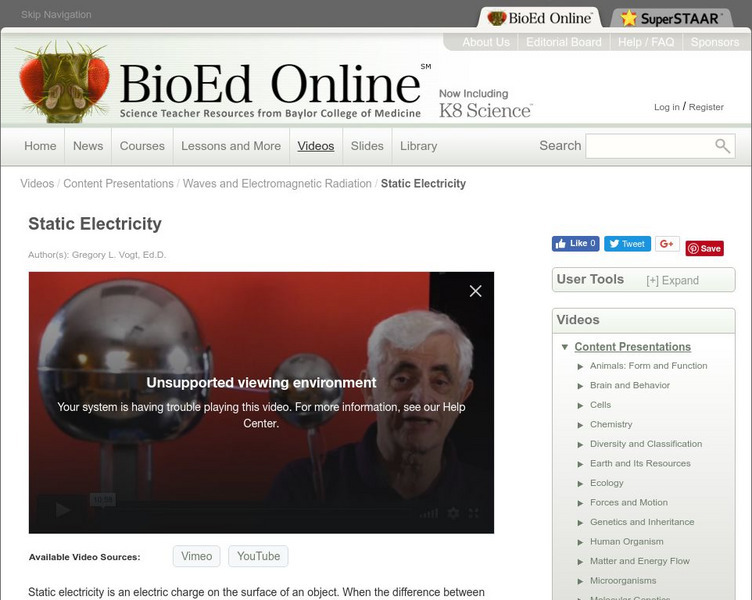Hi, what do you want to do?
Mazz Media
Magnetism
Magnets can be found in many objects that we use everyday. Not only are they located in man-made objects, but magnetic materials can be found in nature as well. In fact, the mineral, magnetite, was found to have magnetic properties long...
Let's Tute
Introduction to Electrical Energy and Its Applications
This video explains the basics of electricity and its various applications in everyday appliances. It introduces the three effects of electric current - heating, magnetic and chemical - and how they are used in different devices. It also...
Wonderscape
Science Kids: Electricity
In this video, students will learn about electricity, including its definition, how it is generated, and how it powers various devices. The video covers topics such as atoms and electrons, static electricity, electric generators, light...
Visual Learning Systems
Magnets and Electromagnetism: Electricity From Magnets
Upon viewing the Magnets and Electromagnets video series, students will be able to do the following: Define a magnet as a material that attracts iron and materials containing iron. Explain that magnets have a north pole and a south pole...
Professor Dave Explains
Conductivity and Semiconductors
Why do some substances conduct electricity, while others do not? And what is a semiconductor? If we aim to learn about engineering and technology, this will be a very important concept, so let's go through the basics now!
Wonderscape
Science Kids: Magnetism and How Magnets Work
This video provides an introduction to magnets and magnetism, explaining how magnets work, their different poles, and their applications in everyday life. It also explores the Earth's magnetic field and its importance, as well as how...
Visual Learning Systems
Thompson's Model of Atoms
In this video, we explore the groundbreaking discoveries of JJ Thompson and his plum pudding model of the atom. Thompson's experiments with electric currents and magnetic charges led him to hypothesize the existence of negatively charged...
Rock 'N Learn
Physical Science for Kids - Lab Safety, Scientific Method, Atoms, Molecules, Electricity, and More
Physical Science for Kids is the fun way to learn important facts about physical science and get ready for tests. Take a fascinating journey to the Super Science Station to learn about lab safety, the scientific method, atoms, molecules,...
Visual Learning Systems
Electrical Circuits Review
This video is a review of the topics covered in the Electrical Circuits series. This video explores the fascinating characteristics of electric circuits, including the flow of electric charges, the production of electric current, and...
Visual Learning Systems
Understanding Electric Circuits
In this video, the teacher explains the concept of an electric circuit using a simple light bulb example. The video also highlights the importance of wires and a switch in controlling the flow of electricity. This video is part of the...
Curated OER
Voltage and Current, Part 2
Second in a two-part lesson on electricity, this video explores how voltage sources can be applied to create electron flow in a circuit. Though it is not modern or high-quality, it is educational. Used with part one, it can sufficiently...
Curated OER
Voltage and Current, Part 1
First in a two-part series, this video is comprised of diagrams, pictures, and animated images explaining how an imbalance of electrons causes them to move. Stored electric charge is revealed as potential energy, and a water tower...
Curated OER
Electromagnetism 4: The Motor Principle
Did you know that electromagnetism can propel a motor? When electric current passes through a conductor in a magnetic field, a force is created which can be used to turn a motor. Cartoon animation and diagrams show you how! The video is...
BioEd Online
Bio Ed Online: Static Electricity
Static electricity is an electric charge on the surface of an object. When the difference between the charge on the object and the charge on a nearby object becomes great enough, a spark of electric current leaps between them. Learn...
PBS
Pbs Learning Media: Exploring Conductivity: Kid Circuits
In this video segment adapted from ZOOM, cast members join hands and become electron conductors to complete an electric circuit. [3:32]
PBS
Pbs Kids: Animations: How Does a Solenoid Work?
Narrated animation visually explains how a solenoid uses a magnetic field to do mechanical work. (30 secs) Uses Quicktime.
PBS
Pbs Kids: Design Squad: Mesmer Tube
Find out what a Mesmer tube is and what happens to the gas inside it when charged with electricity. [0:50]
University of Virginia
Uva Virtual Lab: Bulbs in Parallel
Look at adding an identical bulb to a circuit of a cell and a bulb. In this circuit the two light bulbs are in parallel to each other.
University of Virginia
Uva Virtual Lab: Resistor Waterwheel Analogy
These videos will increase comprehension of how a resistor works by comparing it to a waterwheel.
University of Virginia
Uva Virtual Lab: Capacitor and a Resistor
In this simulation the cell will be used to charge a capacitor. The capacitor will then be used to operate a light bulb until the capacitor is discharged.
University of Virginia
Uva Virtual Lab: Overcharged Water Capacitor
What happens when the voltage across a capacitor exceeds the capacitor's breakdown voltage? This animated illustration will help students make observations.
University of Virginia
Uva Virtual Lab: Capacitor Water Tank Analogy
Understand how an electric current flows in a circuit through an illustration of a water tank pushing water.
University of Virginia
Uva Virtual Lab: Bulbs in Series and Parallel
In this circuit the two light bulbs on the far right are in series with each other. The light bulb in the middle is in parallel to the other two light bulbs.
Crash Course
Crash Course Physics #28: Electric Current
So, electric current works like a river, kinda. Instead of flowing based on elevation, electric current works a little differently. But it's a good metaphor. In this video episode of Crash Course Physics, Shini talks to us about electric...


















